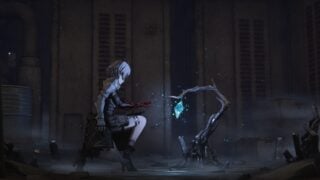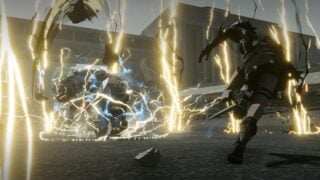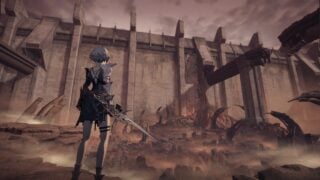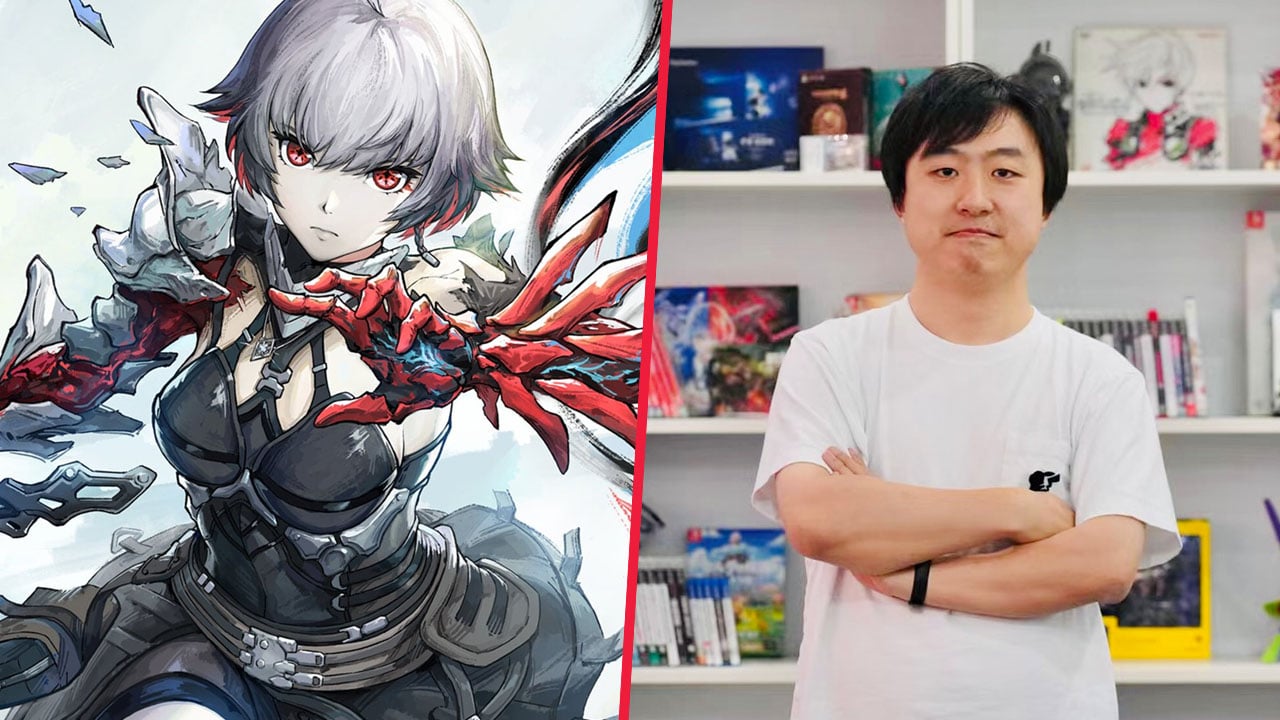Gematsu recently sat down with Yang Bin, producer of PlayStation China Hero Project-supported action RPG AI LIMIT at SenseGames, to discuss the game’s story, world, gameplay, and inspirations ahead of its launch for PlayStation 5 and PC via Steam later in 2024.
Get the full interview below.
Before we get started, can you introduce yourself to our readers, Yang Bin?
Yang Bin, Producer: “Hi, I am Yang Bin, the producer of AI LIMIT. I am glad to be here today.”
Let’s talk first about the game’s story. Can you share more details about the origins of the strange Mud that has spread all over the world and how it shaped the last city of mankind known as Havenswell?
Yang Bin: “Let us find the answer in the game.”
Hmm, OK. So who are the Bladers, and what went into their creation?
Yang Bin: “The Bladers are the only ‘life force’ symbols of the wasteland. I hope their appearance can reflect this idea. They should be vivid and bright, yet not disconnected from the desolation and decay of the wasteland city. Take, for example, Arrisa, our protagonist. She originally had long, bright pink hair in the early designs. As we delved deeper into the game’s world and developed more details, we realized that as a Blader who has spent years crawling and fighting, her appearance should reflect her athleticism more. Therefore, Arrisa now sports cool, short, light pink hair (not white!). Her attire has also evolved from exquisite tailoring to a more post-apocalyptic mix-and-match style, reflecting the limited fashion choices in the barren wasteland.”
Can you tell us about the “wide variety and number of weapons” players will have access to? How many or what kind of weapons can players look forward to?
Yang Bin: “The game has approximately 20 to 30 types of weapons in total. The variety of weapons provides different combat styles and pacing, making combat experiences more diverse. Few of them have been in the previous trailer released on Jananuary 19. For example, the Straight Sword is an all-round weapon with balanced features. The Double Swords are a fast, aggressive attacker. We will disclose more weapons in the future, such as the scythe and Tachi.”
How does the transformation mechanism in the Blader’s left hand affect combat strategies?
Yang Bin: “Arrisa’s left hand can use special Blader’s abilities, such as Spells and skills. Spells, skills, and weapons combined will bring countless fighting styles for players to try. For example, the skill ‘Counter Field’ is similar to ‘parrying.’ It can neutralize enemies’ attacks and then initiate a counterattack. Another skill, ‘Piercing Claw,’ enhances Arrisa’s rage for a more powerful attack upon enemies. There is also a laser-like spell that allows Arrisa to perform long-range attacks to handle different scenarios. These are just a small sample of the skills and spells available. Players will have a wide range of choices to create their own fighting style. If you are interested in seeing more in the future, check our X account.”
Can you tell us about the game’s synchronization system and what role it plays in combat?
Yang Bin: “Sync Rate replaces the Stamina in Soulslike games. This change encourages players to focus more on their quick thinking and adaptability in combat.”
(Editor’s Note: We asked for further clarification on the Sync Rate system—what it is and how it encourages players to focus more on “quick thinking and adaptability” when compared to the Stamina system seen in other Soulslike games—but a public relations representative interjected to clarify that more information will be shared in the leadup to the game’s launch.)

Is combat slow and tactical, or fast and combo-based? If you could compare it to any existing game systems, what would be the closest match?
Yang Bin: “On combat pacing, Arrisa is more agile compared to your average cursed undead in Dark Souls, yet more grounded compared to fast-paced action games. It’s roughly positioned between Dark Souls III and Bloodborne, although individual experiences may vary. Overall, the action performance is quite agile, and the cancellation of recovery animations and aimed stop have been adjusted to a more lenient degree. We hope that players will not feel overwhelmed by enemies in terms of basic attributes, and that the confrontations with enemies will return to a test of skill and mentality.”
Can you talk a little bit about the game’s variety of enemies and the process behind designing them?
Yang Bin: “Because Arrisa, the protagonist, has relatively strong combat abilities compared to other Soulslike games, we have also designed equally capable enemies. Take the Necros, one of the enemy factions in the game, as an example. Necro is a general term for a type of monster that wreaks havoc throughout the city. Their signatures include spikes, blades, tentacles, silver shells, and insect-like wings, symbolizing chaos and slaughter.”
Are enemies unique in that different strategies are required to defeat different foes?
Yang Bin: “Please allow me to continue use Necros as an example. They possess overwhelming strength. Some move with swift and eerie agility, making them elusive and hard to predict. Others have sharp claws and blades that not only deal damage but also inflict very troublesome status effects. Some can harness extremely dense energy to create explosions and rays… Even with enhanced mobility, the onslaught of Necros is by no means easy for players to withstand. Only by leveraging all resources and mastering every aspect of the combat system can one hope to survive this rebellious wasteland.”

How does the narrative integrate into the game? Are there cutscenes and story-focused elements, or is the story mostly told through world interaction?
Yang Bin: “AI LIMIT focused more on gameplay rather than cinematic elements. The game doesn’t have too many ‘force you to watch’ sections. Even if players don’t talk to NPCs at all, they can still beat the game. However, interacting with NPCs allows you to make choices that determine the direction of the story. I hope the different endings provide you with meaningful experiences.”
What was the biggest challenge the development team faced during the game’s development?
Yang Bin: “For a first-time developer, the complexity of the entire project exceeded our expectations. The further we progressed; the more technical issues arose. At certain points in development, iterating on technology caused challenges with maintenance and management. Looking back, we recognize that many of these issues stemmed from our lack of experience as first-timers. However, all of that is now in the past. We believe the game will soon be ready to see the world.”
How has being part of the China Hero Project program benefitted development?
Yang Bin: “Sony Interactive Entertainment offers project management advice and opportunities for market exposure and brand promotion, which are very important to us. Sony Interactive Entertainment also provides middleware, QA, and sound support, plus consulting from PlayStation Studios, all for free. I deeply appreciate it.”
Outside of publishing the game, how did CE-Asia help support development?
Yang Bin: “As the publisher, CE-Asia has provided us with extensive support, including financial backing, marketing, quality assurance, and improvement advice. They are currently managing the global distribution for both console and PC versions of the game, ensuring it gets rated worldwide. Additionally, they are showcasing our game at gaming exhibitions in different regions. Thanks to their assistance, my team can focus on game development.
“I would also like to extend special thanks to Mr. Wu, the CEO of CE-Asia. With over twenty years of experience in the gaming industry, he has a wealth of knowledge. During our collaboration, he has identified many issues we hadn’t considered, helping our team avoid numerous pitfalls and ensuring the smooth progress of our development work.”

What aspects of the game are you proudest of? What do you hope players will take away after their time with the game?
Yang Bin: “To make the fictional world of AI LIMIT more convincing, we put a lot of effort into building this world. We ensured that the content in the game reflects the setting and enhances the player’s immersion. Vegetation is usually used to fill in scene details for the game. However, in AI LIMIT, vegetation has gone extinct, so this method could not be used. We came up with other ways to construct the scenes. Although it was quite challenging, we persevered and made it work.”
Did any other titles serve as an inspiration for AI LIMIT?
Yang Bin: “It is hard to point out one game as the main inspiration. However, I drew a lot of inspiration from classic Japanese works such as GHOST IN THE SHELL, BLAME!, and AKIRA. Additionally, I incorporated some interesting designs into the game.”
Before we sign off, is there anything you would like to say to players looking forward to AI LIMIT?
Yang Bin: “Thank you all for your love for AI LIMIT! The adventure with Arrisa to Havenswell awaits. I hope you will enjoy this game. Stay tuned!”
Thank you so much for your time, Yang Bin!



